- Defects that affect the full stromal thickness and/or endothelial layer
- Late stage or acute keratoconus
- Accidental penetration of the anterior chamber during a lamellar procedure
- Emergency treatment of a perforated corneal ulcer
Advantages
- Surgeons generally have the most experience with this procedure, so outcomes tend to be reliable. Historically, it offers the best visual prognosis.
Disadvantages
- Because the entire central cornea is replaced, this procedure often produces significant postoperative astigmatism and ocular surface changes. Correction may require the use of a hard contact lens.
- It renders the cornea vulnerable to comparatively minor trauma, since strength is significantly reduced even after wound healing.
- In contrast to anterior lamellar procedures, the graft requires careful preoperative screening to ensure adequate donor endothelial cell density. Insufficient cell density leads to graft edema and opacity.
- Since PKP grafts include the highly cellular endothelial layer, the risk of rejection is greater. The corneal stroma consists of laminar collagen and diffuse keratocytes, which are less likely to trigger a host immune reaction.
- There is an increased risk of suprachoroidal hemorrhage and endophthalmitis due to anterior chamber entry.
Anterior Lamellar Keratoplasty (ALK) (FIG. 3.1.1B)
- ALK is superficial stromal opacity or scarring with an intact Descemet’s membrane and healthy endothelium.
Advantages
- The plane of dissection is in the superficial corneal stroma, so the risk of inadvertent anterior chamber penetration is lower than with deep lamellar procedures.
- Donor tissue is easier to obtain and store because the graft does not require viable endothelial cells. Consequently, the risk of rejection is also lower.
- Rehabilitation tends to be quicker than for penetrating procedures, with reduced steroid requirements.
- This procedure is better tolerated in inflamed eyes since the anterior chamber is not entered.
Disadvantages
- Lamellar dissection is more difficult than en bloc removal of the central cornea for PKP.
- Uneven dissection of the donor or recipient cornea can adversely impact postoperative visual acuity.
- Opacity or vascularization may develop at the host–donor interface.
Deep Anterior Lamellar Keratoplasty (DALK) (FIG. 3.1.1C)
- DALK is deeper stromal opacities or scarring with an intact Descemet’s membrane and healthy endothelium.
Advantages
- The plane of dissection is along Descemet’s membrane rather than within the stroma, producing a smoother recipient corneal bed. This theoretically benefits postoperative visual acuity.
Disadvantages
- Deeper dissection increases the risk of accidental anterior chamber perforation. This requires conversion to PKP with its associated risks.
Posterior Lamellar Keratoplasty (FIG. 3.1.1D)
- The preferred treatment for corneal opacity due to endothelial defects that are not associated with independent stromal damage (e.g., bullous keratopathy, Fuchs endothelial dystrophy).
Advantages
- Transplant can be completed through a small limbal or scleral incision. This helps maintain the anterior corneal curvature, limiting postoperative refractive changes and astigmatism.
- Because refractive changes are more predictable, it is possible to perform simultaneous cataract extraction with intraocular lens (IOL) placement.
- Grafts generally adhere to the recipient corneal bed without the need for sutures. Some techniques also permit use of self-sealing incisions.
- Wound healing is generally much faster and less complicated than with PKP. It is therefore safer to suppress endothelial rejection with steroids.
- There is less vulnerability to postoperative trauma, since the required incisions are much smaller.
Disadvantages
- This is the most technically challenging approach because of the need to excise host cornea and manipulate donor tissue through a small incision.
- As with PKP, these procedures require donor tissue with a high endothelial cell density. The rejection risk is therefore greater than for anterior lamellar procedures.
- Despite the use of smaller incisions, there is still a risk of endophthalmitis due to anterior chamber entry.
- Multiple techniques have been developed over the past decade:
- Deep lamellar endothelial keratoplasty (DLEK): A curved blade is used to perform lamellar dissection at 80% to 90% of the stromal depth. Deep stroma, Descemet’s membrane, and the endothelium are then removed and replaced with donor tissue.
- Descemet’s stripping endothelial keratoplasty (DSEK): Descemet’s membrane and endothelium are peeled away without the need for stromal dissection. The graft includes deep stroma, Descemet’s membrane, and the endothelium.
- Descemet’s stripping automated endothelial keratoplasty (DSAEK): Identical to DSEK, except that the donor cornea is dissected with a microkeratome rather than by hand.
- Descemet’s membrane endothelial keratoplasty (DMEK): Similar to DSEK, but the donor cornea is prepared to include only Descemet’s membrane and endothelium. This procedure most closely replicates the preoperative corneal thickness, resulting in the smallest and most predictable refractive change.
- Deep lamellar endothelial keratoplasty (DLEK): A curved blade is used to perform lamellar dissection at 80% to 90% of the stromal depth. Deep stroma, Descemet’s membrane, and the endothelium are then removed and replaced with donor tissue.
ALTERNATIVES
Medical Therapy
Timely intervention may eliminate the need for surgery in some instances (e.g., prompt antibiotic therapy for bacterial keratitis can prevent ulceration and perforation).
- Keratoconus: Hard contact lenses are helpful in early stages, but do not modify disease progression.
- Fuchs endothelial dystrophy: In early stages, topical hyperosmolar solutions can be applied to dehydrate the cornea, temporarily reducing edema and opacity.
Laser/Surgery
- Phototherapeutic keratectomy: Corneal scars can be ablated with an excimer laser if they are confined to the anterior stroma. Up to 20% of the stromal thickness can be removed with this technique.
- Keratoprosthesis: Opaque central cornea is replaced with a clear synthetic implant. This procedure is considered in cases where traditional keratoplasty is expected to fail (e.g., history of recurrent graft rejection or severe ocular surface inflammation).
RELEVANT PHYSIOLOGY/ANATOMY
Cornea Overview
- Clear refractive media: ~ 43 diopters (provides ≥ two-thirds of total refraction).
- Average central thickness: 560 microns (increases with hydration).
- Nourishment: Provided by the limbal capillaries laterally, tear film anteriorly, and aqueous humor posteriorly.
- Sensation: Transmitted by the ophthalmic division of the trigeminal nerve. The corneal reflex is conducted by CN V1 afferent fibers and CN VII efferent fibers.
Corneal Anatomy (FIG. 3.1.2)
Five distinct layers
Epithelium:
- Nonkeratinized stratified squamous epithelium with a thin basement membrane.
- Protects the inner layers from pathogens and the corneal nerve endings from irritation (epithelial defects cause pain and foreign body sensation because the nerve endings are exposed).
- Regenerates rapidly from stem cells located at the corneal limbus.
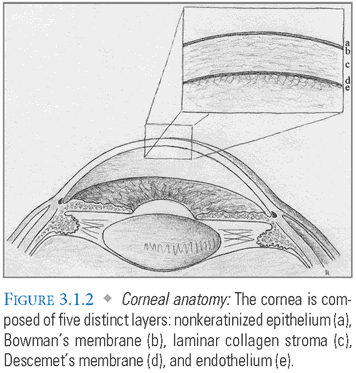
Bowman’s Layer:
- A thin layer of highly organized anterior stroma that is more durable than the overlying epithelium.
- Injury can lead to corneal scarring because it has a limited regenerative capacity.
Stroma:
- Consists of hydrated laminar collagen produced by keratocytes (corneal fibroblasts). Water content is maintained at approximately 70% by the endothelial pump mechanism, which preserves optic clarity. Greater hydration leads to corneal opacity.
- Avascular tissue has slow metabolism and limited cell content. Therefore, this layer is immunologically privileged but easily damaged by infection.
- Chemical injury or prolonged inflammation can induce vascularization, which increases the risk of transplant rejection.
Descemet’s Membrane:
- A thick, durable basement membrane generated by the adjacent endothelial cells.
- As the strongest layer of the cornea, it plays an important role in defining the shape of the anterior chamber.
Corneal Endothelium:
- Regulates stromal hydration with an adenosine triphosphate (ATP)-driven pump-leak system that is critical to maintaining corneal transparency.
- Cell density decreases with age and anterior chamber interventions such as phacoemulsification.
- The normal adult cell count is approximately 2,500 cells/mm2. Below 300 cells/mm2, edema is inevitable due to inadequate pumping.
- Defects in this layer are filled by enlargement and migration since these hexagonal cells cannot divide. Loss of cell symmetry and significant variation in cell size are signs of an unhealthy endothelium.
Relevant Disease Processes
Keratoconus
- Progressive thinning of the cornea causes conical protrusion with severe, irregular astigmatism.
- It can occur sporadically, but there are also known familial and syndromic associations (e.g., Marfan syndrome, Down syndrome, and Ehlers-Danlos syndrome).
- Acute keratoconus results in sudden corneal destabilization and edema due to tears in Descemet’s membrane.
Corneal Dystrophies
- Hereditary metabolic diseases that can affect any layer of the cornea and can lead to bilateral opacity.
- Fuchs endothelial dystrophy is the most common.
Bullous Keratopathy
- Loss of functioning endothelial cells leads to stromal edema and opacity. The overlying epithelium becomes less adherent and develops fluid-filled cysts in the basal layers.
- May be caused by trauma, intraocular inflammation, endothelial dystrophy, or anterior segment surgery.
Corneal Ulcer
- Can be bacterial (most common), viral, fungal, or parasitic.
- May develop within hours of inoculation depending on the pathogen virulence and host immune status.
- Progression: Epithelial lesion, stromal invasion, corneal ulcer, descemetocele (stromal melt exposes Descemet’s membrane), corneal perforation with aqueous leakage, and endophthalmitis.
PREOPERATIVE SCREENING
Evaluate the patient’s visual potential and motivation to comply with lengthy postoperative rehabilitation.
Assess the tear film and lid function since abnormalities can cause ocular surface defects that will delay wound healing.
Slit lamp exam: Check for corneal opacities, edema, and vascularization, as well as for evidence of anterior chamber inflammation (e.g., cell and flare, hypopyon, and synechiae). Accurate assessment of the depth, thickness, and origin of corneal defects is critical to selecting an appropriate procedure.
Specular microscopy: Quantify endothelial cell density using a magnified image to count the several cells within 1 mm2. In addition to central corneal thickness, coefficients for cell symmetry and size variation can be calculated.
Keratometry/video keratography: Measure and document preoperative astigmatism to provide a reference point, since keratoplasty may significantly alter the corneal curvature.
Donor Screening: The eye bank will check for HIV and hepatitis as well as for history of ocular inflammation, malignancy, anterior chamber disease, and prior surgery. Though not routine, human leukocyte antigen (HLA) cross-matching may improve outcomes in patients at high risk of rejection (e.g., prior graft rejection).
ANESTHESIA
Retrobulbar or peribulbar anesthesia is sufficient for most patients undergoing keratoplasty.
Topical anesthesia can be used for some posterior lamellar procedures, but does not provide globe akinesia.
General anesthesia may be necessary for pediatric and uncooperative patients, as well as for obese patients undergoing PKP (the risk of suprachoroidal hemorrhage increases with high intrathoracic pressures, so the patient should be as relaxed as possible).
PROCEDURE
 Penetrating and Anterior Lamellar Keratoplasty: (SEE TABLES 3.1.1 Rapid Review of Steps and 3.1.2 Surgical Pearls, and WEB TABLES 3.1.1 to 3.1.4 for equipment and medication lists).
Penetrating and Anterior Lamellar Keratoplasty: (SEE TABLES 3.1.1 Rapid Review of Steps and 3.1.2 Surgical Pearls, and WEB TABLES 3.1.1 to 3.1.4 for equipment and medication lists).
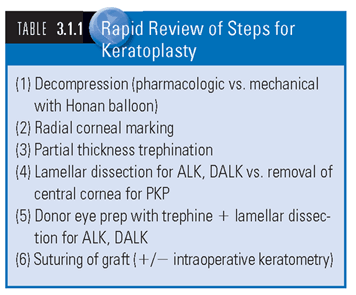

- Preoperative Medication: In preparation for PKP, the globe is decompressed pharmacologically (with IV mannitol) or mechanically (with a Honan balloon, FIG. 3.1.3) to reduce the risk of suprachoroidal hemorrhage and intraocular content prolapse. Miotics are often used to constrict the pupil in phakic patients, protecting the native lens from intraoperative trauma. These measures are not necessary in anterior lamellar procedures, since the anterior chamber is not entered.

- Globe Stabilization: The globe can be stabilized with traction sutures placed near the limbus or beneath the rectus muscles (FIG. 3.1.4), or with a Flieringa scleral fixation ring.
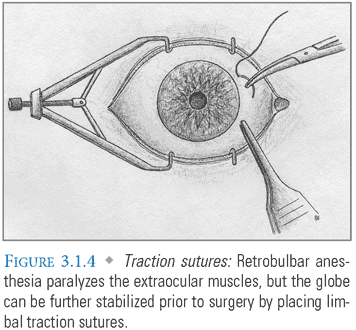
- Trephination: Castroviejo calipers are used to locate the center of the cornea and to mark the desired radius of excision (FIG. 3.1.5). Radial lines are then stained onto the corneal epithelium, using a radial keratotomy marker (FIG. 3.1.6A,B). This aids in centering the graft and in optimizing suture locations. A partial-thickness circular incision is then made in the cornea with a vacuum trephine (FIG. 3.1.7). It should be large enough in diameter to remove the defect of interest and avoid the visual axis, while maintaining sufficient distance from the limbal vessels, which carry inflammatory cells that mediate graft rejection. Incision depth depends on the several trephine revolutions (one-fourth turn = 60 microns) (FIG. 3.1.8). In lamellar procedures, lateral dissection with a blade, microkeratome, or laser permits removal of epithelium and stroma with exposure of the underlying “recipient bed” (FIG. 3.1.9). In penetrating procedures, the circular incision is completed in a controlled fashion with a fine scalpel and scissors (FIG. 3.1.10A,B).

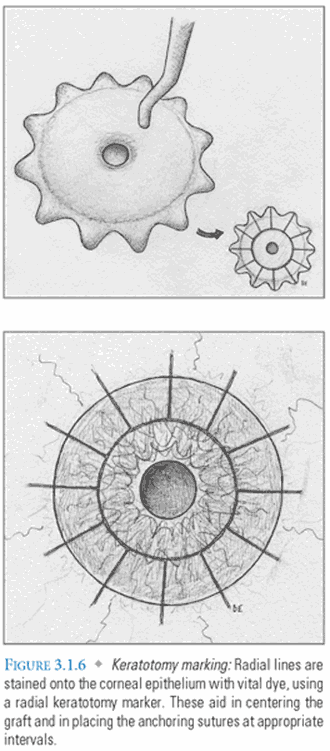
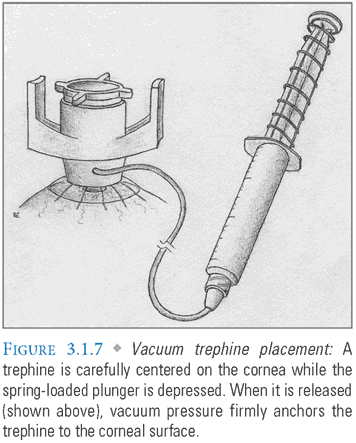



- Donor Eye Preparation: For lamellar keratoplasty, trephination and lateral dissection can be used to harvest a corneal graft of the desired diameter and thickness from the donor eye. Alternatively, microkeratome-prepared cornea can be obtained in various thicknesses. It theoretically improves visual potential by providing a smoother donor–host interface than free-hand dissection. For PKP, a full-thickness graft of the appropriate diameter is harvested from the donor cornea with a trephine, taking care to avoid damage to the endothelial surface (FIG. 3.1.11).

- Graft implantation: For lamellar procedures, the graft is placed onto the recipient bed and secured with radial 10-0 sutures through 90% of the host corneal thickness. For PKP, four “cardinal” sutures are initially placed at the 12, 3, 6, and 9 o’clock positions after injection of viscoelastic to support the anterior chamber (FIG. 3.1.12). Closure is then completed with running or interrupted sutures after viscoelastic aspiration (FIG. 3.1.13). A keratometer can be used intraoperatively to guide suture tensioning and to minimize postoperative astigmatism. After closure is complete, the wound is tested for leaks by infusing balanced salt solution (BSS) through a paracentesis tract in the peripheral cornea.

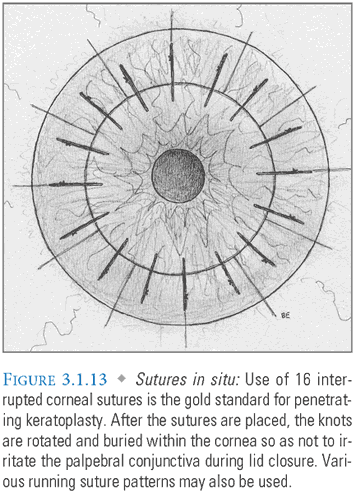
 Posterior Lamellar Keratoplasty: DSEK/ DSAEK/DMEK: (SEE TABLES 3.1.3 Rapid Review of Steps and 3.1.4 Surgical Pearls, and WEB TABLES 3.1.5, 3.1.6, and 3.1.7 for equipment and medication lists).
Posterior Lamellar Keratoplasty: DSEK/ DSAEK/DMEK: (SEE TABLES 3.1.3 Rapid Review of Steps and 3.1.4 Surgical Pearls, and WEB TABLES 3.1.5, 3.1.6, and 3.1.7 for equipment and medication lists).
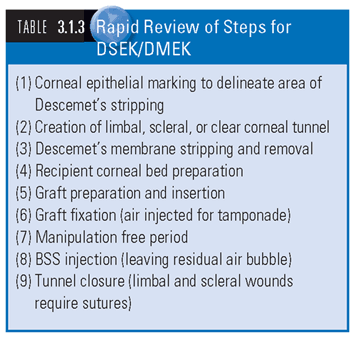
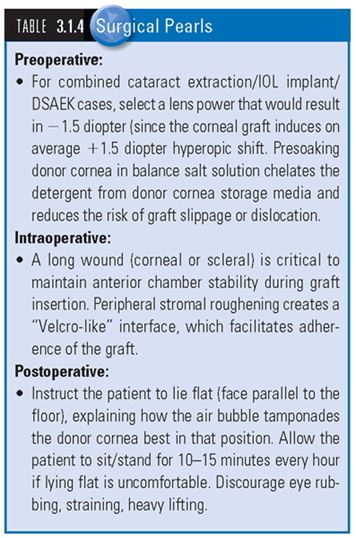
- Preoperative Medication: As with PKP, the globe is decompressed.
- Corneal Marking: Castroviejo calipers are used to locate the center of the cornea and to mark the desired radius of Descemet’s membrane stripping. A circular outline is then stained onto the corneal epithelium (FIG. 3.1.14).
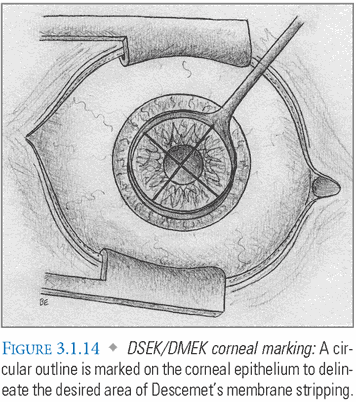
- Scleral/Limbal Tunnel: A flap of temporal conjunctiva adjacent to the limbus is elevated with sharp dissection. Specialized blades are then used to create a tunnel through the underlying sclera and into the peripheral anterior chamber (FIG. 3.1.15). This tunnel must be wide enough to accommodate the folded donor graft. Corneal curvature will be reduced in the meridian of this incision, producing astigmatism. The degree of flattening is directly related to incision length, and inversely related to distance from the central cornea. Since the required incision is longer than those used for cataract phacoemulsification, it is generally placed further from the central cornea. If transplant is combined with cataract surgery, however, some surgeons will perform both procedures through a limbal or clear corneal incision.
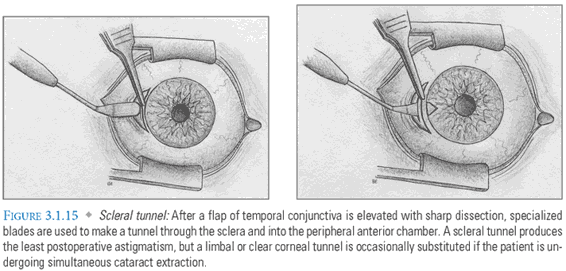
- Host Tissue Removal: The anterior chamber is filled with viscoelastic to maintain its curvature during scoring of Descemet’s membrane. A reverse Sinskey hook is then inserted through a paracentesis wound. The tip of the hook is used to penetrate Descemet’s membrane and it is swept in a circular motion using the epithelial marking as a guide (FIG. 3.1.16). The posterior layers of the central cornea, including Descemet’s membrane and endothelium, are then bluntly dissected away from the anterior cornea and removed from the anterior chamber with Utrata forceps (FIG. 3.1.17). This creates a smooth recipient bed for donor tissue implantation.
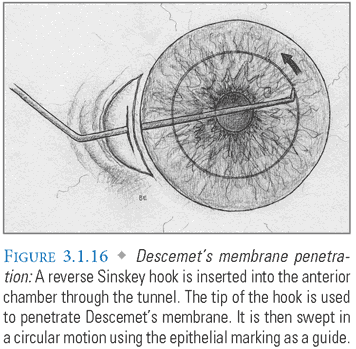
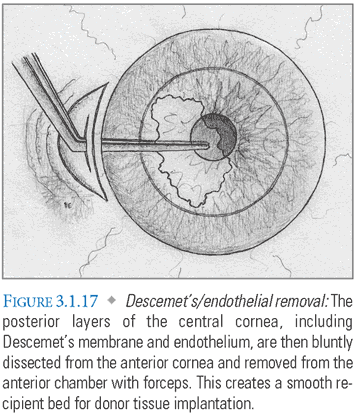
- Recipient Bed Preparation: Since the incidence of postoperative graft dislocation is relatively high, some surgeons attempt to increase donor tissue adhesion by roughening the peripheral recipient bed with a scraping tool. An irrigation-aspiration unit is then used to remove the viscoelastic and remnants of Descemet’s membrane.
- Graft Preparation and Insertion: The donor cornea is dissected into anterior and posterior layers, either by hand or with a microkeratome. Many eye banks now offer predissected cornea. After lamellar dissection, a trephine is used to harvest a circular graft of appropriate diameter. Grafts for DSEK and DEAEK include deep stroma, Descemet’s membrane, and endothelium, while those for DMEK omit the deep stroma. After the endothelial surface of the graft is coated with viscoelastic for protection, it is folded in half and inserted through the scleral tunnel with forceps (FIG. 3.1.18). Some surgeons have begun to insert the folded graft using an intraocular lens injection system, which can be used in conjunction with a smaller clear corneal incision.

- Fixation of Donor Graft: The graft is then unfolded by reinflating the anterior chamber with BSS on a cannula and centered using gentle manipulation. Air is injected posterior to the graft, filling the entire anterior chamber and tamponading the donor tissue firmly against the recipient stromal surface. Some surgeons massage the cornea with a laser-assisted in situ keratomileusis (LASIK) flap roller to squeeze residual fluid from the host–donor interface. Careful removal of all interface fluid decreases the incidence of postoperative displacement. The presence of air in the anterior chamber can produce pupillary block and precipitate acute angle closure (FIG. 3.1.19). This is prevented with routine peripheral iridectomy (FIG. 3.1.20) or pharmacologic pupillary dilation.

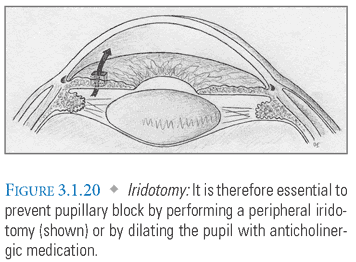
- Closure: After a 10-minute manipulation-free period, BSS in injected, leaving a residual air bubble that occupies 30% of the anterior chamber volume. The temporal tunnel is often closed with dissolvable 9-0 Vicryl sutures, though corneal and limbal incisions may be self-sealing. The conjunctival flap is then reapproximated and closed with Vicryl sutures.
COMPLICATIONS
Intraoperative
- Suprachoroidal hemorrhage: Accumulation of blood between the choroid and sclera. The risk increases with high thoracic or IOP (PKP).
- Prolapse of intraocular contents: Expulsion of intraocular tissue through the corneal incision. The risk increases with high IOP (PKP).
- Anterior chamber perforation: Necessitates conversion to PKP (anterior lamellar procedures).
Postoperative
- Astigmatism: The single most common factor limiting postoperative visual acuity, assuming a healthy posterior segment. In management, corrective suture removal or adjustment must be balanced against adequate corneal wound healing (PKP, anterior lamellar).
- Wound leakage: Causes anterior chamber shallowing, hypotony, and increased risk of infection. Detected with the Seidel test: Leaking aqueous will dilute fluorescein placed over the surgical wound (PKP, rarely posterior lamellar).
- Graft dislocation: The most common complication of posterior lamellar procedures. Detached grafts can be repositioned and anchored by reinjecting air into the anterior chamber.
- Persistent epithelial defects: May result from an uneven interface between the host and donor corneal surfaces. This complication is especially common in eyes with prior surface defects (PKP, anterior lamellar).
- Loose sutures: Can serve as a nidus for corneal vascularization and/or infections such as suture abscess (PKP, anterior lamellar).
- Corneal ulcers: May form in the setting of persistent epithelial defects or suture abscess. They can also present due to recurrence of preoperative corneal infection.
- IOP elevation: In PKP, this is most often due to occlusion of the trabecular meshwork with inflammatory cells, hyphema, or residual viscoelastic material. In posterior lamellar procedures, injection of air into the anterior chamber can precipitate angle closure.
- Primary graft failure: The cornea remains opaque after transplantation due to inadequate pumping by the endothelial layer. In general, wait 2 to 4 weeks to see if the graft will ultimately clear before reintervention (PKP, posterior lamellar).
- Endophthalmitis: The risk of intraocular infection increases with anterior chamber entry (PKP, posterior lamellar).
- Interface irregularity: Optical distortion at the host–donor interface in anterior lamellar procedures. The risk is greater with free-hand stromal dissection.
- Interface opacity and/or vascularization: Occasionally seen with anterior lamellar procedures.
- Graft rejection: Mostly seen with PKP and posterior lamellar procedures due to greater graft cellularity. Treated with corticosteroids, it occurs in three forms.
- Epithelial rejection: Lymphocytes from the limbal vasculature destroy peripheral cells; visible as punctate fluorescein staining on the slit lamp exam. This form of rejection is self-limited, since the donor epithelium is ultimately replaced with host tissue.
- Subepithelial infiltrates: Signs of stromal rejection include discrete areas of opacity that may leave scars following resolution.
- Endothelial rejection: This can lead to rapid corneal opacity due to pump mechanism failure. Anterior chamber inflammation and/or keratic precipitates may be visible on the slit lamp exam. A leading rejection line (Khodadoust line) is often apparent on the posterior corneal surface.
- Epithelial rejection: Lymphocytes from the limbal vasculature destroy peripheral cells; visible as punctate fluorescein staining on the slit lamp exam. This form of rejection is self-limited, since the donor epithelium is ultimately replaced with host tissue.
POSTOPERATIVE CARE
Instruct patients who have undergone posterior lamellar procedures utilizing an air bubble to lie face up in the recovery room (maintains graft position). They must also be cautioned to avoid rubbing their eyes.
On the first postoperative day, assess pain, intraocular pressure, visual acuity, and graft position. Perform slit lamp and fundus exams.
With PKP, apply topical corticosteroids for 1 month, then taper based on appearance of the graft. Eyes with high rejection risk may require a very long steroid taper and/or an indefinite basal dose. With lamellar procedures, steroids are generally necessary for shorter periods.
Administer antibiotics until the epithelial defects heal.
Eye protection is essential, especially following PKP. Counsel the patient to wear glasses or an eye shield at all times during the postoperative period. The patient must also avoid the Valsalva maneuver or heavy lifting.
Monitor graft edema with serial ultrasound pachymetry (central corneal thickness increases with hydration).
After several weeks of healing, manage astigmatism by adjusting running sutures or removing select interrupted sutures in clinic. The timing of final suture removal is highly variable and must be individualized.
Further Reading
Text
Lang GK. Cornea. In: Lang GK, ed. Ophthalmology–A Pocket Textbook Atlas 2nd ed. New York, NY: Georg Thieme Verlag; 2007:chap 5.
Marten L, Wang MX, Karp CL, et al. Corneal surgery. In: Yanoff M, Duker J, eds. Ophthalmology. 3rd ed. Philadelphia, PA: Mosby; 2009:351–360.
Panda A, Vanathi M, Kumar A, et al. Corneal graft rejection. Surv Ophthalmol. 2007;52(4):375–396.
Price MO, Price FW. Descemet’s stripping endothelial keratoplasty. Curr Opin Ophthalmol. 2007;18(4): 290–294.
Tan DT, Mehta JS. Future directions in lamellar corneal transplantation. Cornea. 2007;26(9 Suppl 1):S21–28.
Primary Sources
Bahar I, Kaiserman I, McAllum P, et al. Comparison of posterior lamellar keratoplasty techniques to penetrating keratoplasty. Ophthalmology. 2008;115(9):1525–1533.
Ham L, Dapena I, van Luijk C, et al. Descemet membrane endothelial keratoplasty (DMEK) for Fuchs endothelial dystrophy: Review of the first 50 consecutive cases. Eye. 2009;23(10): 1990–1998.
Price FW Jr, Price MO. Descemet’s stripping with endothelial keratoplasty in 200 eyes: Early challenges and techniques to enhance donor adherence. J Cataract Refract Surg. 2006;32(3):411–418.
A clear synthetic prosthesis, secured to a ring of donor tissue, is used to replace severely opacified host cornea.
The Boston Type 1 prosthesis, originally known as the Dohlman-Doane device, is the most commonly used KPro and has been FDA approved since 1992 (FIG. 3.2.1). The Alpha Cor prosthesis is a common alternative.
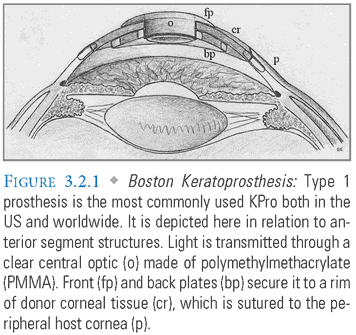
Stay updated, free articles. Join our Telegram channel

Full access? Get Clinical Tree


